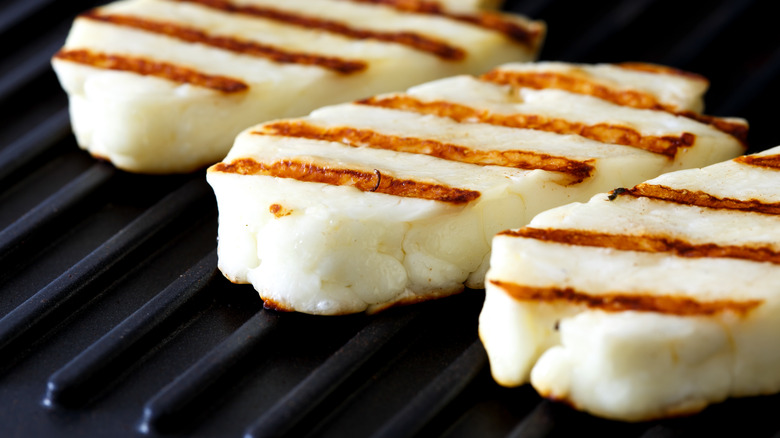What's The Difference Between Halloumi And Paneer Cheese?
There are far more cheeses out there than varieties like cheddar, mozzarella, and parmesan. From Central Asia's kurt cheese balls to the moose milk cheese produced on a farm in Sweden, you're not starved for options when it comes to unique cheeses as long as you're willing to look for them. And two varieties of cheese which you really should try are halloumi and paneer.
It's important to note that while you could theoretically substitute halloumi and paneer for each other if you don't have any other options, it will drastically change whatever you're making because these two cheeses are wildly different. They're both melt-resistant, but beyond that, there's not a lot in common between them, as they have totally different flavors, textures, and nations of origin. And as soon as you know what to look for, you won't confuse one for the other. These two cheeses are processed differently, the root of which comes down to one basic component: acid.
It's acid that makes paneer and halloumi different
Of the two, paneer is probably eaten by more people — which isn't surprising since it rose to prominence in India, one of the world's most populous countries. Though paneer has long been part of North Indian cuisine, the working theory is that it didn't start there, having been introduced to the area by Persians and Afghanis. By contrast, halloumi is from a much smaller country: Cyprus, an island nation in the Mediterranean. While paneer is usually made from buffalo milk (though cow's milk also works), halloumi is usually a mixture of sheep and goat's milk.
But more than anything, it's the differing role of acid in each cheese's production that sets them apart. Paneer is made by bringing milk to a gentle boil and then adding an acid (usually lemon juice or vinegar), which separates the curds from the whey. The resulting mixture then has the whey strained off, typically through a muslin cloth.
Halloumi, meanwhile, is made with almost no acid whatsoever. It's heated the same way as paneer, but instead of lemon juice, it makes use of rennet to separate its curds from its whey. Rennet is an animal enzyme, stuff from a calf's (or other mammal's) stomach sometimes used to make cheese – although a vegetarian version is available. This means halloumi is not always suitable for those on a vegetarian diet, while paneer is.
Halloumi and paneer are usually cooked very differently
The result of both these processes is a cheese designed not to melt — strangely, both high acid content and low acid content inhibit melting — but the way you'd use halloumi vs. paneer is generally pretty different owing to their differing qualities. Halloumi's texture is firm and rubbery, kind of like the cheese curds popular in the American Midwest, while paneer tends to be soft and crumbly. Halloumi is also saltier, while paneer is more mild.
The most common way to cook halloumi is to grill or pan-fry it. Though it won't melt, halloumi will develop a gorgeous brown crust when cooked, and its firm texture makes it useful as a meat substitute (particularly the vegetarian varieties). Indeed, the way to make sure your halloumi cheese is perfectly cooked is to use a spatula to check its softness to make sure it doesn't burn. Paneer, meanwhile, has a much more pronounced tendency to soak up the flavors around it, which is why it's so useful in curries like saag paneer and palak paneer.
Could you theoretically put halloumi in palak paneer and have it work? Maybe. But the texture will feel different, so it's probably better to use each of these cheeses to its own unique strength.


